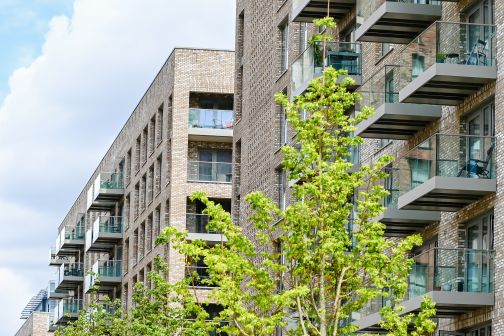How to specify the right heat pump for your residential project: Environmental and planning concerns

This blog is focussed on the environmental and planning concerns that should be considered when specifying heat pumps for residential projects. The information is an excerpt from the white paper ‘A technical guide to the specification of heat pumps for single dwellings and multi-occupancy residential or mixed-use developments’. The blog will give you an idea of the level of detail contained within the white paper that provides valuable insight into all the areas that influence specification choices for residential projects.
There are many types of heat pumps, and they can all be affected by environmental factors and planning requirements. We will highlight the key areas for consideration to help to ensure that the right heat pump is specified for your residential project.
Which environmental and planning considerations are key to the selection of the right heat pumps residential projects?
Each type of heat pump comes with its own set of environmental and planning considerations. The list provided here is not exhaustive but covers key considerations to be made. Manufacturers can often provide environmental and planning (E&P) consultants with guidance on individual solutions that they offer. E&P consultants are best placed to offer evaluation and recommendations based on the heat pump specification for the project.
Noise
Noise pollution and vibration during the operation of ground and water source heat pumps are almost negligible. Where their application is feasible and noise is a primary concern for the project, this makes them favourable options for specification. Air Source Heat Pumps (ASHPs) in general, emit more noise than ground or water source heat pumps, however, some are available in special casings to limit any noise disturbance.
It would be prudent to factor in low-level noise and avoid installation in courtyards or enclosed spaces where noise can otherwise be magnified. Split system ASHPs differ from monobloc models as they separate the heat pump components between an indoor and outdoor unit. They are connected by refrigerant lines, and this allows the outdoor unit to be installed some distance from the property if required to reduce the impact of any noise generated. An exception applies to ducted ASHPs installed within the dwellings. These include hot water heat pumps and other technologies such as ambient loops used in multi-occupancy dwellings, that have been explicitly designed to overcome the issues associated with their specific location of installation.
Air quality and pollution
Traditional heat pumps do not cause air pollution or require a flue. Their impact on air quality is minimal. This is a critical specification consideration in projects situated within protected environments or in areas where a reduction in air pollution levels is vital. Heat pumps can also be used in densely populated urban areas, where thermal pollution gives rise to urban heat islands. The benefits are increased in systems capable of using waste energy for a second purpose. For example, the waste energy from a heat cycle is used to cool spaces and vice versa. By preventing the excess heat from dispersing into the environment and using it as many times as possible before doing so, further increases in the temperature of the urban heat island can be mitigated, with a coinciding improvement in efficiency.
Planning requirements
Environmental planning requirements will depend on the type of heat pump specified. Closed-loop Water Source Heat Pump (WSHP) systems do not typically require environmental permits or approvals if the Environmental Good Practice Guide (EGPG) is followed. In contrast, open-loop WSHP systems are regulated and require Environment Agency permits in all cases. Open-loop WSHP systems also require extraction and a discharge license from the Environment Agency. Geological checks are necessary for ground source heat pumps (GSHPs) to establish the thermal and conductivity properties of the bedrock for vertical loops and superficial deposits for a horizontal loop. Whilst heat pumps fall under permitted development, air source heat pumps (ASHPs) may be subject to planning permission if the development is outside planning limits and conditions. Further conditions may be imposed in different areas, and the local authority should be contacted to verify any regional requirements.
Life cycle carbon cost
Heat pumps contain a small amount of refrigerant. Automatic leak detection is a requirement if refrigerant is present. The benefit is early detection of any issues that limit environmental damage and facilitate more efficient maintenance. If the cooling function of a heat pump can replace the output of a refrigerant-based air conditioning system, heat pump installation should be considered as the more energy-efficient alternative. To establish accurate carbon savings estimates, various performance factors affecting the operating carbon costs over the life cycle of the technology should be considered. The lifetime figures will vary considerably depending on the design of the HVAC solution, the efficiency of the building envelope and the design of the building itself.
Neil Hudson of S&P Coils in Heat Pumps; Performance and carbon savings notes that 30% of carbon savings in operational carbon costs can be expected. Detailed life cycle energy use plans for buildings are expected to be mandatory in the future as outlined by the new draft London Plan. The strategy would make calculations and re- ductions in life cycle carbon emissions, both operational and embodied, compulsory and change the landscape of HVAC specification.
What other factors should be considered when specifying heat pumps for residential projects?
As well as the environmental and planning concerns we have covered in this blog, there are other key factors that should be taken into consideration when specifying heat pumps for residential project.
These include:
- Project design and site constraints
- Efficiency, capital and running costs
- Compliance and futureproofing
- Installation
For further information from Dimplex that will help guide the specification of heat pumps for your project, our comprehensive white paper is free to download. If you have any further questions about heat pumps or other low carbon HVAC solutions, please contact our team today who will be happy to help.








